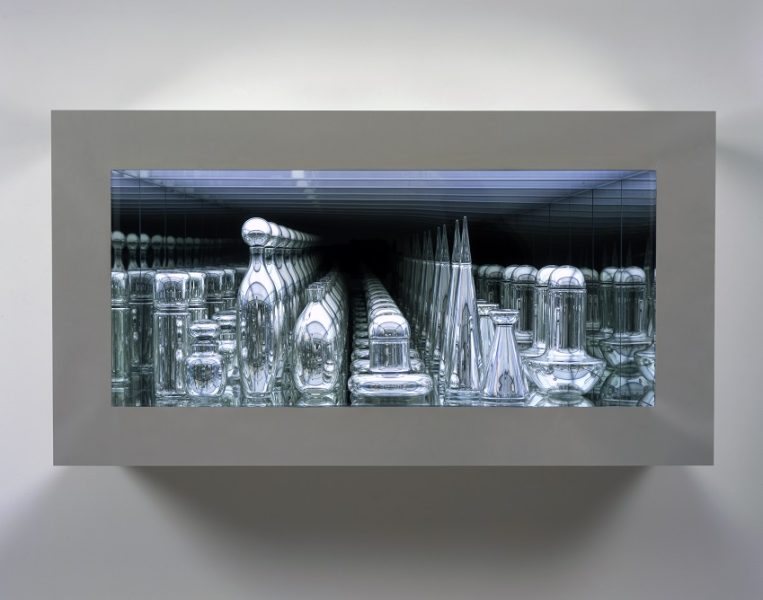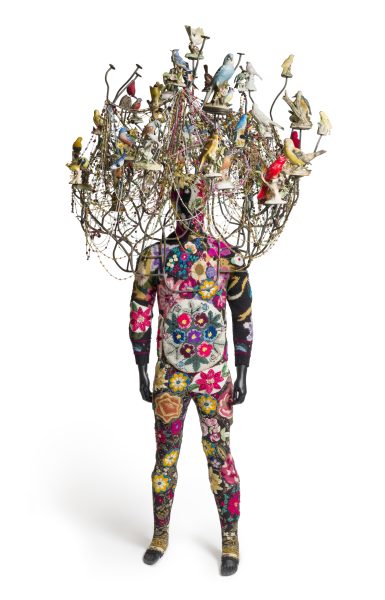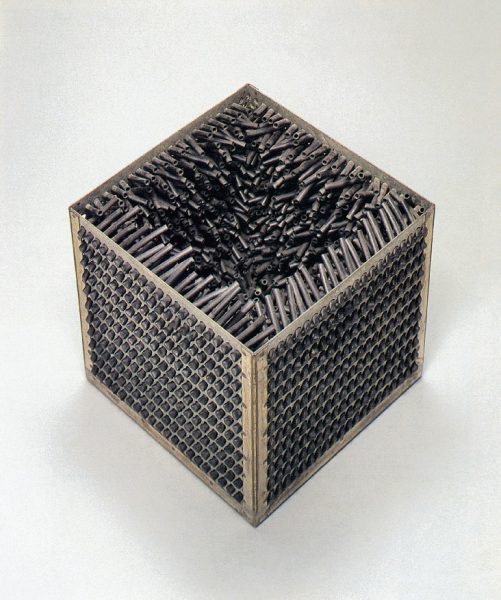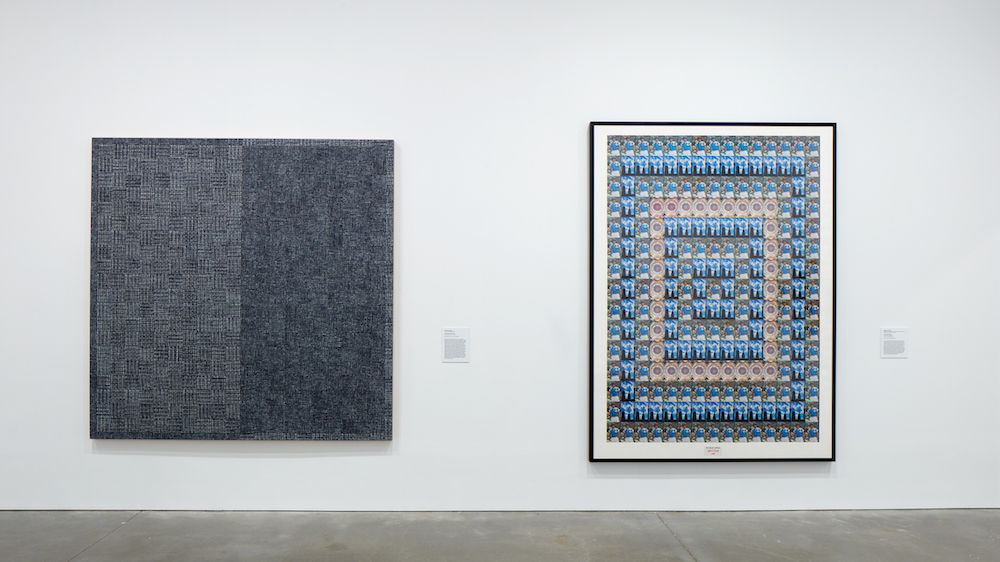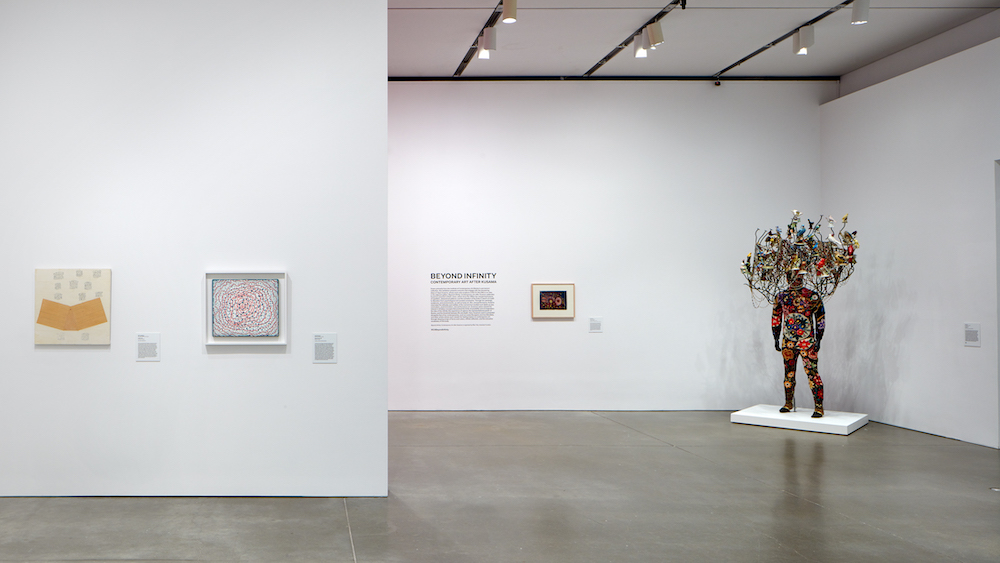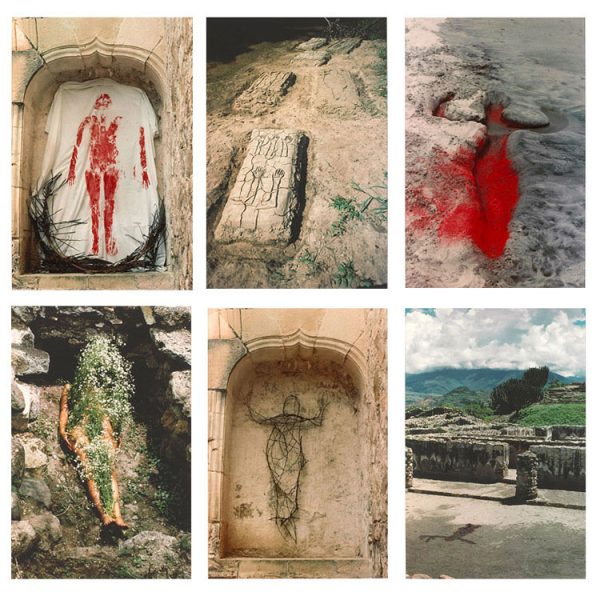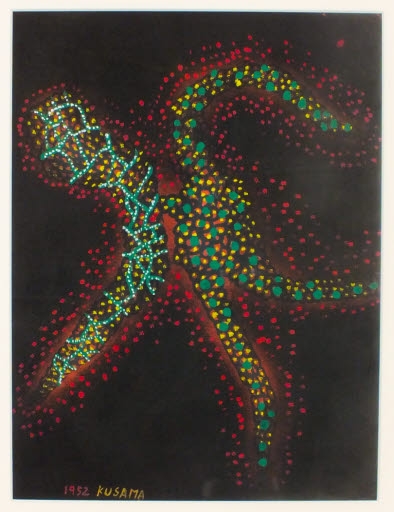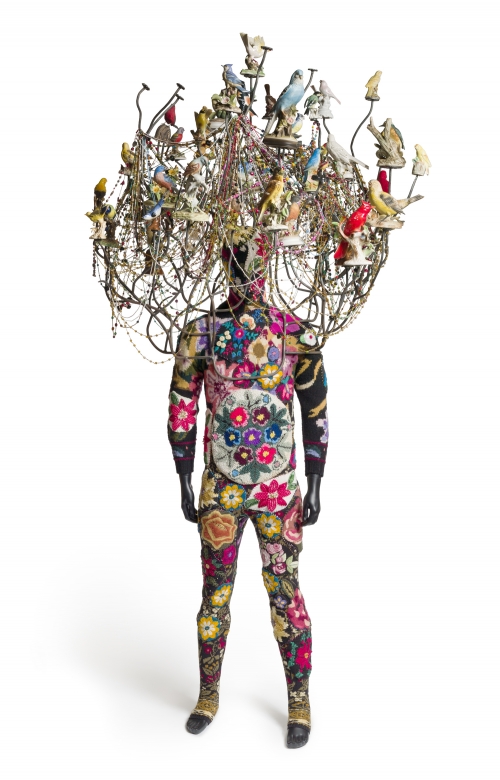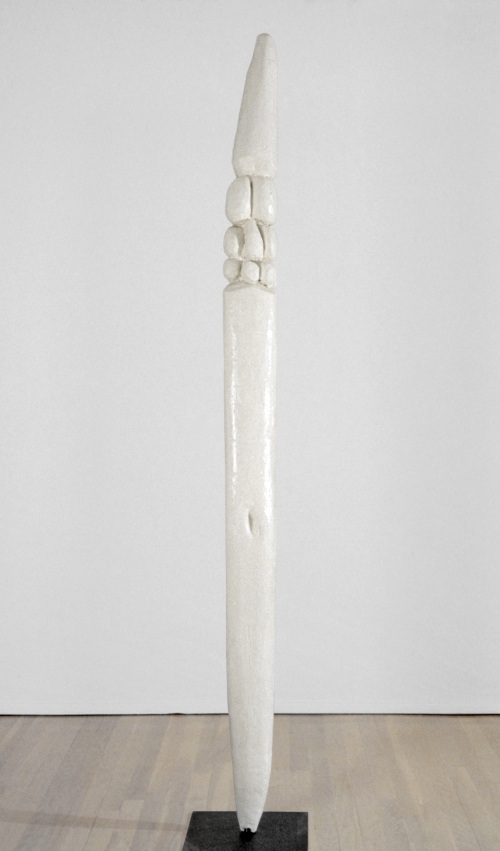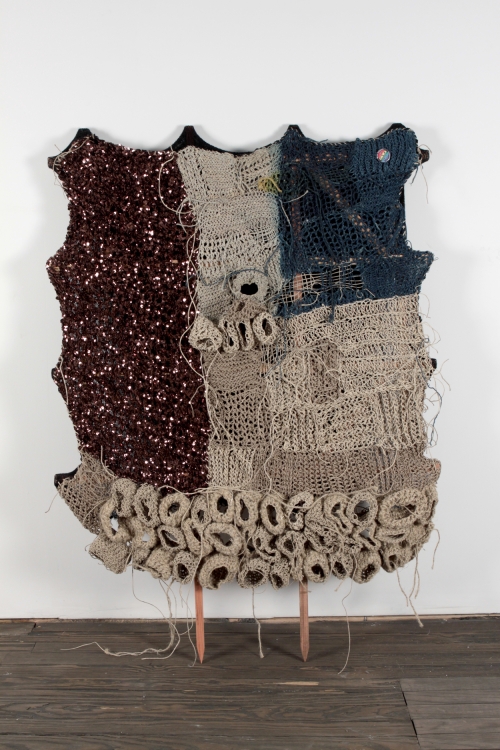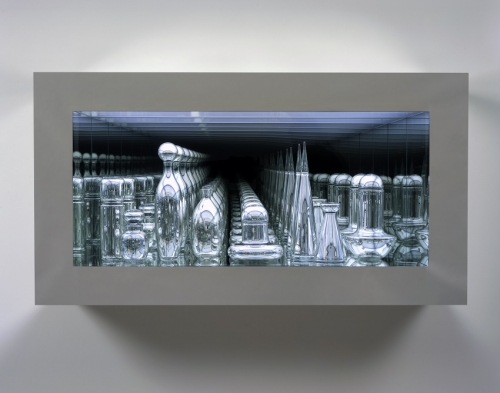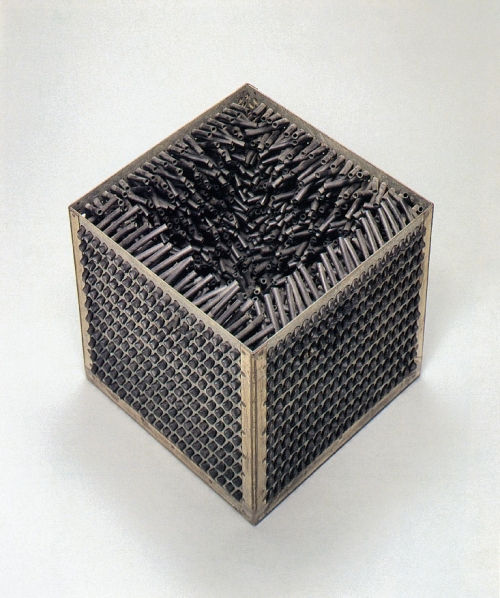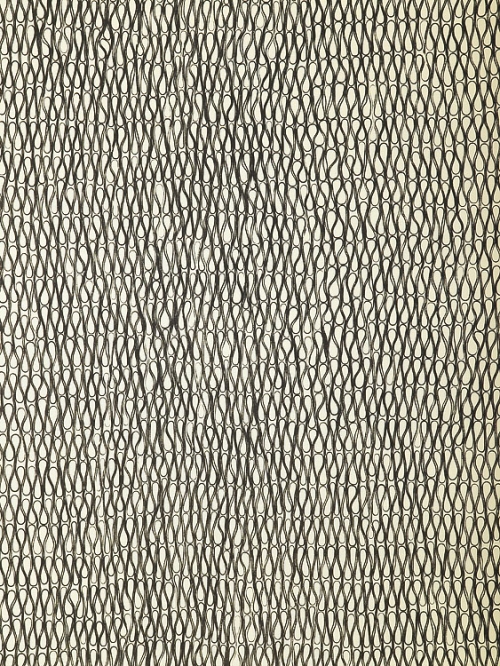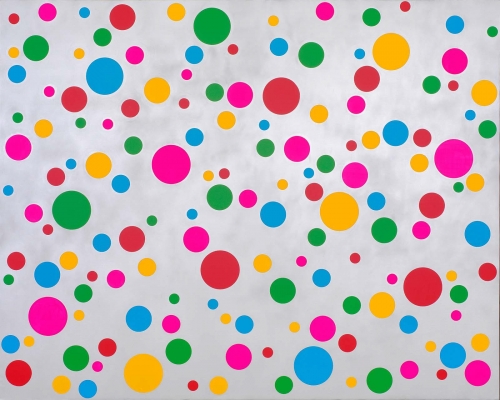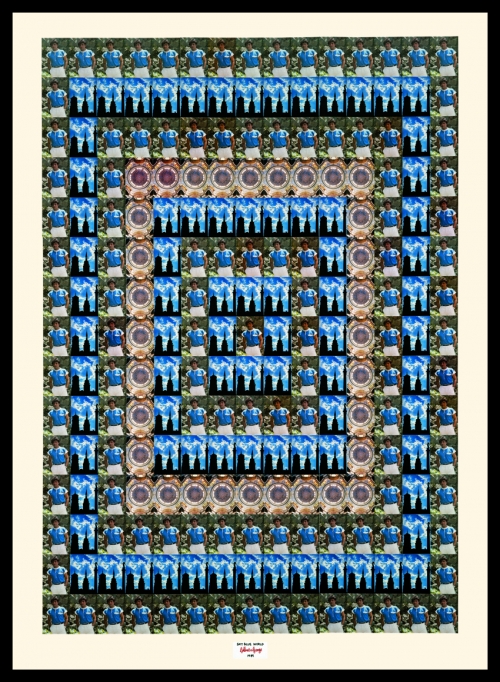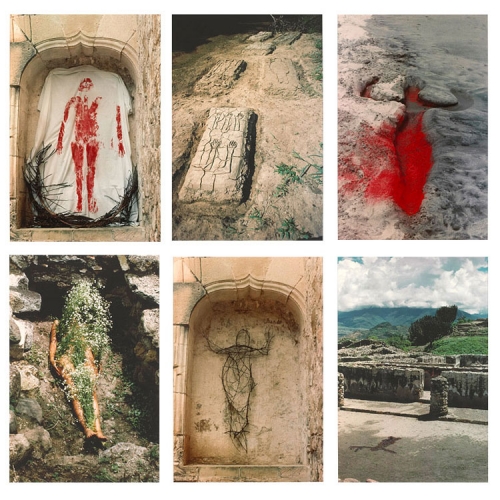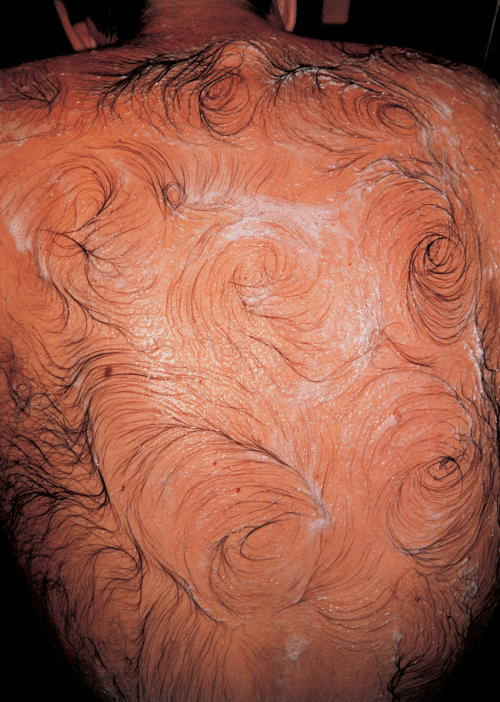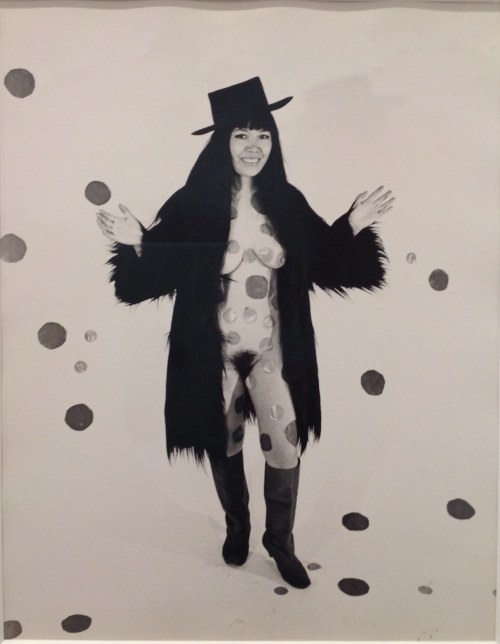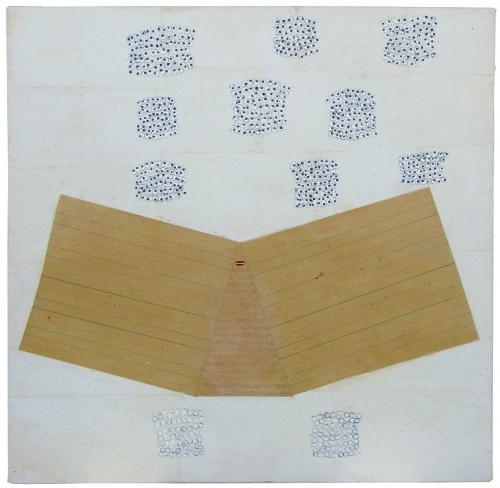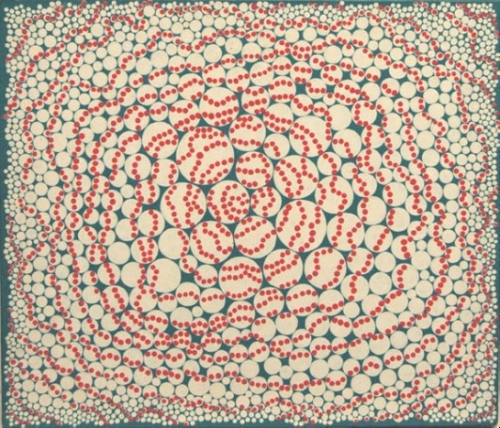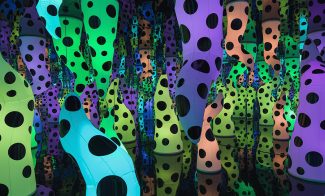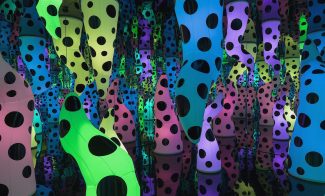Drawn primarily from the ICA’s permanent collection, this exhibition presents artworks that engage with the pioneering ideas of Yayoi Kusama (b. 1929, Matsumoto, Japan). Beyond Infinity: Contemporary Art after Kusama celebrates Kusama’s prescient artistic vision, which since the 1950s has merged techniques of repetition, obsessional patterns, and the activation of the body in search of a path to liberation from psychological and societal constraints. Through her paintings, sculptures, and environments, as well as body art, film, and performance, Kusama channeled the attitudes and realities of the moment but avoided such labels as pop, minimalism, postminimalism, and performance art. Kusama’s peers shared her interest in timeless concepts that pushed the limits of possibility and of imagination: the idea of the infinite; the experience of rapture; the representational power of illusion; and the threshold between life and death. Here, Kusama’s work is presented alongside that of her contemporaries, such as Louise Bourgeois and Ana Mendieta, and other artists whose work builds on her lasting impact on contemporary art through dizzying arrays of forms and colors, infinite reflection, and the evocative vocabulary of the body.
Note: Yayoi Kusama: LOVE IS CALLING is currently closed following a review of air flow and safety needs during Covid-19.
Educational materials
Object labels PDF
Yayoi Kusama
(Born 1929 in Matsumoto, Japan)
Untitled, 1952
Gouache on paper
Peabody Essex Museum, Gift of the Estate of Mark A. Fischer, 2016
Working across the mediums of painting, photography, sculpture, video, and immersive installations for over six decades, Kusama has retained certain motifs, such as the representation of light, dots, and sexual forms throughout her work. Untitled is one of Yayoi Kusama’s early works, made in Japan before the artist moved to the United States in 1957. This was a particularly prolific time for Kusama, during which she produced hundreds of new paintings and drawings for her first exhibition in 1952, many of which included references to the natural world. The abstract, fluorescent scattering of dots that form tentacles, imagines the microscopic and biological as much as the celestial and otherworldly. It is an early example of her experimentation with dots, which appear frequently throughout her work.
Nick Cave
(Born 1959 in Fulton, Missouri)
Soundsuit, 2009
Mixed media
Gift of Steve Corkin and Dan Maddalena
Since the early 1990s, multimedia artist and performer Nick Cave has been exploring the intersection of fine art, craft, performance, and material culture. He first gained widespread recognition in the art world for his Soundsuits—full-body costumes crafted from twigs, buttons, figurines, toys, and other eye-catching bric-a-brac gathered from flea markets and antique shops. Their kitschy, exuberant aesthetic conceals their serious connotations: Cave first devised the Soundsuit in 1991 as a protective “second skin” in response to the racial profiling and brutal beating of Rodney King—an unarmed black man—by four Los Angeles police officers. Like Yayoi Kusama, Cave explores the power of dissolving the body in color and pattern, imagining the absence of one’s identity and even one’s self beneath the accumulation of repeated forms. Though the artist often displays the Soundsuits as sculpture, he also wears them as costumes for live performances, photographs, and videos, combining performative movement with their dramatic appearance and noise-making materials.
Louise Bourgeois
(Born 1911 in Paris, France; died 2010 in New York)
Untitled, 1947-49
Wood and paint
Gift of Barbara Lee, The Barbara Lee Collection of Art by Women
Sculptor, feminist, and influential artist Louise Bourgeois produced a distinctive oeuvre over her 70-year career, combining abstraction and figuration and a wide array of media to explore such themes as the body, trauma, and sexuality. Bourgeois and Yayoi Kusama were contemporaries and pioneering figures in their own right, both known as obsessive, prolific makers who employed the evocative bodily fragment as a formal vocabulary for negotiating memory and emotion. One of several major sculptures by Bourgeois in the ICA/Boston collection, Untitled is one of the artist’s early carved and painted-wood totemic sculptures, which she referred to as “personages.” Starkly vertical, thin, and luminescent, Untitled is an abstract, almost tusk-like form that suggests both the fragility of the upright human figure and the soaring reach of architecture. The influence of the surrealists on Bourgeois is apparent in this work, in which the tension between the familiar and unfamiliar becomes paramount as the figurative adopts a new form.
Josh Faught
(Born 1979 in Saint Louis, Missouri)
Untitled, 2009
Hemp, sequins, pin, and wooden garden trellis
Gift of Andrew Black
Josh Faught’s fiber-based sculptures employ a range of materials, including yarn, lamé, wool, linen, scrapbooking materials, and cast-off items. He transforms these eclectic media into complex assemblages with handmade techniques, such as crochet, weaving, dyeing, and painting. In Untitled, loosely geometric fields of color contrast with an array of barnacle-like forms, introducing an organic, material language conversant with that of Yayoi Kusama, Louise Bourgeois, and Eva Hesse. The entire textile is stretched over a wooden garden trellis, like a canvas on an easel, inviting additional analogies with painting. Like Kusama’s soft sculptures, Faught’s labor-intensive work draws on personal histories of gender and sexual politics, balanced with an urgent sense of anxiety embedded in the present.
Josiah McElheny
(Born 1966 in Boston, Massachusetts)
Czech Modernism Mirrored and Reflected Infinitely, 2005
Mirrored glass case with handblown mirrored glass objects
Purchased through funds provided by Bridgitt and Bruce Evans, Kimberly and James Pallotta, Beth and Anthony Terrana, and Nancy B. Tieken in honor of Jill Medvedow
Josiah McElheny is known for installations of handmade glass objects in precisely designed displays, whose accompanying explanatory texts or titles entice us to reflect on the objects’ origins in traditional craft. In McElheny’s work, abstract ideas such as perfection, infinity, and utopia are recast as physical artifacts shaped by history, culture, science, and the contemporary context of their display. Striking for its craftsmanship and conceptual rigor, Czech Modernism Mirrored and Reflected Infinitely presents a line of eight polished decanters through a pane of one-way glass in a volume that appears to endlessly recede into space. The surface of each object reveals its own infinite reflection, but never our own—a hermetic, modernist vision devoid of the subject. In that sense, this perceptually stimulating piece can be seen as a response to Yayoi Kusama’s Infinity Mirror Rooms, and especially her installation Narcissus Garden, in which she filled a patch of lawn at the 1966 Venice Biennale with 1,500 mirrored plastic balls that she offered for sale, indulging the visitor’s narcissistic impulses while wryly participating in the art world’s commercialization.
Eva Hesse
(Born 1936 in Hamburg, Germany; died 1970 in New York)
Accession IV, 1968
Galvanized steel and rubber tubing
Gift of Barbara Lee, The Barbara Lee Collection of Art by Women
Until her untimely death in 1970, Eva Hesse worked in regular dialogue with some of the most influential minimalist, postminimalist, and conceptual artists in 1960s New York—including Mel Bochner, Dan Graham, and Sol LeWitt. Hesse’s work reflected that circle’s emphasis on fabrication techniques and rigorously structured sculptural processes. Her Accession series (1967–68), four iterations of which still exist, was based on the primary form of the cube. In each sculpture, Hesse threaded rubber tubing through perforations in the walls of a square box open at the top. Rigid and aggressively protective in its form, but soft and biomorphic in its surface, Accession IV is exemplary of postminimalist sculpture, fusing repetition, geometry, and industrial materials with suggestions of the psychically and psychologically loaded spaces of our built environment. Yayoi Kusama became friends with Hesse through her then-studio mate Donald Judd; both women were celebrated for their pioneering and rigorous experiments with malleable materials, psychological symbolism, and serial processes.
Tara Donovan
(Born 1969 in Queens, New York)
Untitled (Rubber Bands), 2006
Relief print from rubber band matrix
Gift of Bruce A. Beal and Robert L. Beal, in honor of Barbara Krakow
Tara Donovan focuses on the nature of accumulation and the use of repetition to transform everyday objects: “I assemble units that I reproduce and collect in various ways to discover how they will behave visually in a population.” Untitled (Rubber Bands) emerged from an experimental process of using rubber bands to create prints, which Donovan considers drawings. In this relief print, she carefully assembled rubber bands into a densely repetitive pattern that she then inked and pressed onto paper. The screen-like, looping pattern recalls bold, graphite pencil scribbles, or perhaps the weave of fabric. Like Yayoi Kusama, Donovan employs accumulation and dense repetition to create dizzying optical effects, and elevates the material’s humble origins into something unexpected—here highlighting the aesthetic potential of elasticity.
Yayoi Kusama
(Born 1929 in Matsumoto, Japan)
Dots Infinity NOWH, 2004
Acrylic on canvas
Museum of Fine Arts, Boston, Charles H. Bayley Picture and Painting Fund
Yayoi Kusama’s use of polka dot and net patterns, which proliferate throughout her painting, sculpture, and environments, originate in hallucinations she experienced as a child when such patterns dominated her field of vision. Deploying this phenomenon as an aesthetic and conceptual strategy, Kusama embraced this visual language both as a means of coping with her illness and as a generative language that could unite the individual to the universe in a process that she described as “self-obliteration.” As early as 1963, Kusama suggested the use of geometric pattern as a matrix that linked the self to others, and to the world: “When we obliterate nature and our own bodies with polka dots, we become part of the unity of our environment.” Kusama made Dots Infinity NOWH around the same time that she resumed making room- size installations after a long hiatus. Its metallic ground and candy-colored dots loosely evoke her early Infinity Mirror Rooms, such as Peep Show/Endless Love Show, which featured multicolored blinking lights.
Gilbert & George
(Gilbert Prousch: born 1943 in San Martin de Tor, Italy; George Passmore: born 1942 in Plymouth, United Kingdom)
Sky Blue World, 1989
From the series 25 Worlds
Postcards mounted on board
Gift of Sandra and Gerald Fineberg
Gilbert & George emerged in East London in the late 1960s with a range of performance and photo-based work driven by the anti-elitist slogan “art for all.” Sky Blue World is from the series 25 Worlds, in which identical postcards, often picturing handsome men, are arranged in large, concentric, patterned fields. Here, identical postcards of Indian Bollywood screen idol Govinda alternate with postcards featuring a banal seascape turned on its side and an architectural scene of a temple-like structure. The kaleidoscopic pattern, both psychedelic and almost cosmological, presents its celebrity figure as a subject of veneration. Like Yayoi Kusama’s obsessive painting practice, characterized by dense accumulations of geometric forms intended to evoke the infinite expanse of the universe, Gilbert & George’s dizzying array combines the devotional with the everyday.
Ana Mendieta
(Born 1948 in Havana, Cuba; died 1985 in New York)
Silueta Works in Mexico, 1973–77/1991
Pigmented inkjet prints
Gift of Barbara Lee, The Barbara Lee Collection of Art by Women
The body is a central component in Ana Mendieta’s performances, photographs, and films. She began the Silueta (“silhouette”) series in 1973 while on a trip to Oaxaca, Mexico, which reminded her of Cuba—her birthplace—in its blending of the Old and New Worlds. In her first Silueta, Mendieta laid naked in a Zapotec tomb with white flowers strewn over her body, evoking themes of transience and mortality, and drawing a metaphorical relationship between the body and nature. In subsequent Siluetas created in Mexico and Iowa (where she attended graduate school), the artist covered her body with a range of substances, including rocks, blood, sticks, and cloth. Through the body’s imprint and its disappearance into landscape, Mendieta collapses the visual and sensual experience of nature through the elements of earth, water, air, and fire, emphasizing the fragility of the human being in relation to these forces.
Mona Hatoum
(Born 1952 in Beirut, Lebanon)
Van Gogh’s Back, 1995
Chromogenic color print
Gift of Barbara Lee, The Barbara Lee Collection of Art by Women
Mona Hatoum has frequently used the body, including her own, in photographic, film-based, and performative work. In Van Gogh’s Back, Hatoum transforms the familiar body in uncanny and playful ways. Here, an individual’s back hair has been massaged into frothy curls that reprise Vincent van Gogh’s signature swirling brushstrokes in his iconic 1889 painting Starry Night. Hair has featured in the artist’s practice both materially and metaphorically, as a form of drawing and as sculptural material. In this photograph, as in Yayoi Kusama’s happenings, the human body functions as canvas and sculpture, bearing traces of tactile interaction and playful tenderness.
Fred W. McDarrah
(Born 1926 in New York; died 2007 in New York)
Yayoi Kusama, Performance Artist, 1967/1970
Gelatin silver print
Collection of Gerald S. and Sandra Fineberg
Amidst the tumult of the Vietnam War, as well as the women’s rights, civil rights, and gay rights movements in the United States, Yayoi Kusama staged participatory actions that were both utopian and political in nature. Ranging from orgiastic celebrations of free love to antiwar protests, they expressed her belief that love could fuel transcendence. Kusama’s highly staged and controversial interventions occurred in visible sites throughout Manhattan, including Central Park, the New York Stock Exchange, the Statue of Liberty, and the United Nations building. Presiding over these environments of nude dancers, body painting, music, and moving images as the “high priestess of polka dots,” she ceremoniously painted her trademark patterns on participants’ nude bodies as a way of problematizing the boundaries between subject and object. Her belief that audience participation was essential to the act of art-making reflected a broader perspective shared by many artists and countercultural figures in the 1960s. Kusama’s happenings, as well as her artistic persona-here seen in a posed studio portrait-were well-documented by photographers, including Fred McDarrah.
Ellen Gallagher
(Born 1965 in Providence, Rhode Island)
Untitled, 1995
Oil, pencil, and paper
Gift of Ellen Matilda Poss
Since the early 1990s, Ellen Gallagher has explored the history and representation of African Americans through methods of material and optical transformation. Her early paintings and works on paper are minimal compositions that employ repetition and found materials in dialogue with historical abstraction and postminimalism—by artists such as Yayoi Kusama, Agnes Martin, and Eva Hesse. Gallagher regularly appropriates images from historically black magazines, from which she cuts, collages, obscures, and transforms the original material to critique consumer culture. In Untitled—an exemplary early work—fields of bulging, rolling eyes cluster around a primary shape made of collaged penmanship paper; at its center, a small set of smiling red lips reveals white teeth. Referencing the minstrel show, which she has called the “earliest American abstraction,” Gallagher’s deployment of cartoonish eyes and lips accumulate stereotypical tropes of the black figure into the seemingly neutral forms of geometric abstraction.
Yayoi Kusama
(Born 1929 in Matsumoto, Japan)
Beyond the Sky, 1988
Acrylic on canvas
Collection of Beth and Richard Marcus
In 1959 Yayoi Kusama began making large oil paintings covered in arcs, loops, and wavelike forms, and first exhibited them in Boston’s Nova Gallery (1955-60), an artist’s cooperative on Stanhope Street. She termed these rhythmic, screen-like paintings Infinity Nets—as if they could capture infinite space— describing their making as follows: “I gradually feel myself under the spell of the accumulation and repetition in my ‘nets’ which expand beyond myself, and all over the limited space of canvas covering the floor, desk and everywhere.” In the ensuing decades, the nets featured different colors, compositions, and textures, though they all share a protocol of making: a central nucleus initiates an expanding cluster of circles. In Beyond the Sky what appears as the ground of the painting is in fact a densely packed net of white dots through which one sees radiating skeins of connected red dots. The pattern seems at once microscopic and macroscopic, evoking Kusama’s visualization of infinity. Kusama called this merging of figure and ground “obliteration,” seeing the blending of immediate space with the space of the beyond as a metaphor for the union of self and other.
